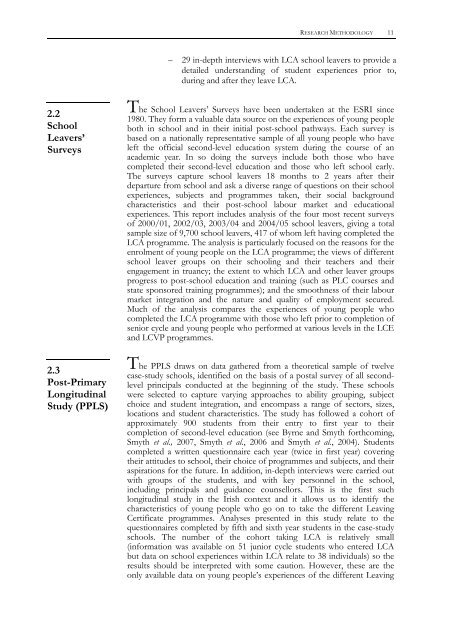Student Experiences of the Leaving Certificate Applied Programme
Student Experiences of the Leaving Certificate Applied Programme
Student Experiences of the Leaving Certificate Applied Programme
You also want an ePaper? Increase the reach of your titles
YUMPU automatically turns print PDFs into web optimized ePapers that Google loves.
RESEARCH METHODOLOGY 11– 29 in-depth interviews with LCA school leavers to provide adetailed understanding <strong>of</strong> student experiences prior to,during and after <strong>the</strong>y leave LCA.2.2SchoolLeavers’SurveysThe School Leavers’ Surveys have been undertaken at <strong>the</strong> ESRI since1980. They form a valuable data source on <strong>the</strong> experiences <strong>of</strong> young peopleboth in school and in <strong>the</strong>ir initial post-school pathways. Each survey isbased on a nationally representative sample <strong>of</strong> all young people who haveleft <strong>the</strong> <strong>of</strong>ficial second-level education system during <strong>the</strong> course <strong>of</strong> anacademic year. In so doing <strong>the</strong> surveys include both those who havecompleted <strong>the</strong>ir second-level education and those who left school early.The surveys capture school leavers 18 months to 2 years after <strong>the</strong>irdeparture from school and ask a diverse range <strong>of</strong> questions on <strong>the</strong>ir schoolexperiences, subjects and programmes taken, <strong>the</strong>ir social backgroundcharacteristics and <strong>the</strong>ir post-school labour market and educationalexperiences. This report includes analysis <strong>of</strong> <strong>the</strong> four most recent surveys<strong>of</strong> 2000/01, 2002/03, 2003/04 and 2004/05 school leavers, giving a totalsample size <strong>of</strong> 9,700 school leavers, 417 <strong>of</strong> whom left having completed <strong>the</strong>LCA programme. The analysis is particularly focused on <strong>the</strong> reasons for <strong>the</strong>enrolment <strong>of</strong> young people on <strong>the</strong> LCA programme; <strong>the</strong> views <strong>of</strong> differentschool leaver groups on <strong>the</strong>ir schooling and <strong>the</strong>ir teachers and <strong>the</strong>irengagement in truancy; <strong>the</strong> extent to which LCA and o<strong>the</strong>r leaver groupsprogress to post-school education and training (such as PLC courses andstate sponsored training programmes); and <strong>the</strong> smoothness <strong>of</strong> <strong>the</strong>ir labourmarket integration and <strong>the</strong> nature and quality <strong>of</strong> employment secured.Much <strong>of</strong> <strong>the</strong> analysis compares <strong>the</strong> experiences <strong>of</strong> young people whocompleted <strong>the</strong> LCA programme with those who left prior to completion <strong>of</strong>senior cycle and young people who performed at various levels in <strong>the</strong> LCEand LCVP programmes.2.3Post-PrimaryLongitudinalStudy (PPLS)The PPLS draws on data ga<strong>the</strong>red from a <strong>the</strong>oretical sample <strong>of</strong> twelvecase-study schools, identified on <strong>the</strong> basis <strong>of</strong> a postal survey <strong>of</strong> all secondlevelprincipals conducted at <strong>the</strong> beginning <strong>of</strong> <strong>the</strong> study. These schoolswere selected to capture varying approaches to ability grouping, subjectchoice and student integration, and encompass a range <strong>of</strong> sectors, sizes,locations and student characteristics. The study has followed a cohort <strong>of</strong>approximately 900 students from <strong>the</strong>ir entry to first year to <strong>the</strong>ircompletion <strong>of</strong> second-level education (see Byrne and Smyth forthcoming,Smyth et al., 2007, Smyth et al., 2006 and Smyth et al., 2004). <strong>Student</strong>scompleted a written questionnaire each year (twice in first year) covering<strong>the</strong>ir attitudes to school, <strong>the</strong>ir choice <strong>of</strong> programmes and subjects, and <strong>the</strong>iraspirations for <strong>the</strong> future. In addition, in-depth interviews were carried outwith groups <strong>of</strong> <strong>the</strong> students, and with key personnel in <strong>the</strong> school,including principals and guidance counsellors. This is <strong>the</strong> first suchlongitudinal study in <strong>the</strong> Irish context and it allows us to identify <strong>the</strong>characteristics <strong>of</strong> young people who go on to take <strong>the</strong> different <strong>Leaving</strong><strong>Certificate</strong> programmes. Analyses presented in this study relate to <strong>the</strong>questionnaires completed by fifth and sixth year students in <strong>the</strong> case-studyschools. The number <strong>of</strong> <strong>the</strong> cohort taking LCA is relatively small(information was available on 51 junior cycle students who entered LCAbut data on school experiences within LCA relate to 38 individuals) so <strong>the</strong>results should be interpreted with some caution. However, <strong>the</strong>se are <strong>the</strong>only available data on young people’s experiences <strong>of</strong> <strong>the</strong> different <strong>Leaving</strong>

















